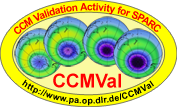AC&C/SPARC Ozone
Database for CMIP5
This website decribes the AC&C
/ SPARC
Ozone Database that has been created in support of CMIP5. It
covers the period 1850 to 2100 and
can be used as ozone forcing
for CMIP5 models that do not include interactive chemistry. The ozonedatabase is provided in CF
compliant netCDF format (T3M fields: Monthly-mean 3-d atmosphere data
(longitude, latitude, pressure, time:month) ).
Contact for questions: Veronika
Eyring,
Irene Cionni (DLR, Germany),
Jean-Francois
Lamarque (NCAR, USA)
, and
Bill Randel (NCAR, USA)
A. The historical part of the
AC&C/SPARC ozone database covering the period 1850 to 2009 is now available at the
CMIP5 website at PCMDI. The
historical ozone data combine separate stratospheric and tropospheric
data sources:
- The stratospheric data are
constructed using a multiple linear regression analysis of SAGE I+II
satellite observations and polar ozonesonde measurements for the period
1979-2005, as described in Randel and Wu (JGR, 2007). The regression
includes terms representing equivalent effective stratospheric chlorine
(EESC) and 11-year solar cycle variability.
- The stratospheric time series
are extended backwards to 1850 based on the regression fits combined
with extended proxy times series of EESC and solar variability.
- Tropospheric data are derived
from model simulations. The tropospheric ozone simulations were
performed using the chemistry-climate models Community Atmosphere
Model(CAM) version 3.5 and the NASA-GISS PUCCINI model. Both models
simulate tropospheric and stratospheric chemistry with feedback to the
radiation and were driven by the recently available historical
(1850-2000) emissions succintly described in Lamarque et al. (IGAC
Newsletter, May 2009). Emissions are kept constant from 2000 onwards in
both simulations. In addition, CAM was using sea-surface temperatures
(SSTs) from a previous CCSM3 simulation while the NASA-GISS model used
observed SSTs (Hadley Centre dataset of Rayner et al., JGR, 2003). The
simulation for CAM was a full transient 1850-2005 (after a 10-year
spinup at 1850) while the NASA-GISS model performed snapshots every 20
years from 1850 to 1930 and every 10 years thereafter, with data taken
from the last 6 years of 8 year simulations. For the climatology,
decadal averages were performed for each model, then the NASA-GISS
results were interpolated to the CAM vertical grid and an average of
both was taken. This average field represents the tropospheric ozone
field in the climatology.
- The stratospheric and
tropospheric data are combined by simply merging the two data sets
across the climatological tropopause, to produce a smooth final data
set. Example plots are available below.
FINAL VERSION RELEASED ON 22 SEP 2009
B. The future part of the
AC&C/SPARC ozone database covering the period 2010 to 2099 is now available at the
CMIP5 website at PCMDI.
The future timeseries is a seamless extension of the historical
database (merged in the year 2009), so that the entire time series
(1850-2100) can be used as ozone forcing for climate models that do not
include interactive chemistry. The future ozone timeseries combines
separate stratospheric and tropospheric data sources: (1) The
stratospheric ozone projections are taken from the future reference
simulations (REF-B2) of the 13 CCMs that performed a future simulation
until 2100 under the SRES A1b GHG scenario and the A1 adjusted halogen
scenario in CCMVal-2 (see Chapter 9 of the SPARC CCMVal Report at
http://www.atmosp.physics.utoronto.ca/SPARC). In the stratosphere, the
multi-model mean of the REF-B2 simulations is used in all RCP scenarios
(i.e. stratospheric ozone in this database doesn’t vary among the
RCPs). (2) The future tropospheric ozone time series continues the
historical CAM3.5 simulation until 2100 using the four different
Representative Concentration Pathways (RCPs) that were generated by
Integrated Assessment Models (IAMs) and were harmonized with the
historical emissions from Lamarque et al. (ACP, 2010) in both amplitude
and geographical distribution. Since RCP based simulations from an
Atmosphere-Ocean climate model were not available when these runs were
started, SSTs/SICs from SRES simulations closest to the RCP GHG
scenarios were used. (3) As in the historical part, the future
stratospheric and tropospheric data are combined by simply merging the
two data sets across the climatological tropopause, to produce a smooth
final data set. Citation: Cionni et al. (2010), see below."
C. Reference. A
paper that desribes the AC&C/SPARC ozone database has
now been published in ACPD and is open for Interactive Public
Discussion until 02 Jun 2011:
Cionni, I.,
V. Eyring, J.
F. Lamarque, W.
J. Randel, D. S. Stevenson, F. Wu, G. E. Bodeker, T. G. Shepherd, D. T.
Shindell, and D. W. Waugh, Ozone
database in support of CMIP5 simulations: results and corresponding
radiative forcing,
Atmos. Chem.
Phys. Discuss., 11, 10875-10933, doi:10.5194/acpd-11-10875-2011,
2011.

